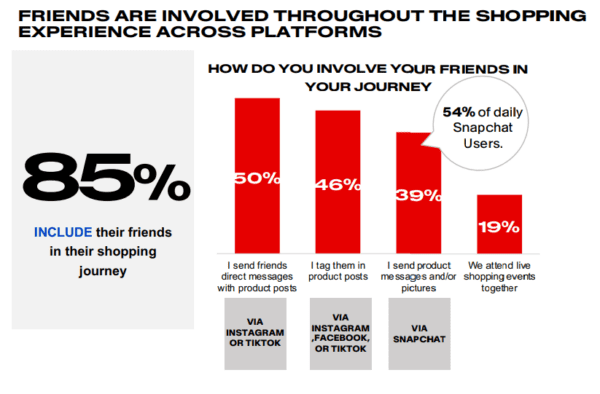It’s no secret that social commerce — that is, retail interactions that begin (and sometimes also end) on social media platforms — is big business. With 4.74 billion social media users globally active daily on platforms like Facebook, Instagram, TikTok and Snapchat, social commerce is expected to drive revenues of $492 billion this year, according to Global Payments.
It’s also no secret that brands and platforms are still figuring out the best way to get their piece of this massive pie, although that’s certainly not stopping them from trying — more than 50% of the businesses surveyed by Global Payments said they plan to sell through social platforms this year.
New research from Havas Media Network, in partnership with Snap, Inc., illuminates how brands can more effectively harness the social behavior of what they have dubbed “Gen Next,” the combination of Gen Z and millennials encompassing consumers aged 13 to 34. The partners surveyed 28,500 of this desirable consumer set from across the U.S., UK, France, Germany, India, Mexico and United Arab Emirates, and found that not only is Gen Next interested in social commerce, but most of them already are engaging in it.
“Our research found that 64% of Gen Z and millennials have made a purchase through social media in the past year,” said Seema Patel, Global Managing Director of Mx Intelligence at Havas Media Network in a statement. “These younger audiences embrace social commerce, and with this report we sought their input on how we can create a more meaningful and engaging social commerce journey.”
Here are some of the report’s key findings:
Social Media is Now Integral to Online Shopping
Whether deliberate or unplanned, over two-thirds of Gen Next agreed that social media plays an integral role at all stages in their online shopping, and particularly in the discovery stage: 88% said they use social media to discover new products or window shop for inspiration, and 44% said they use it to evaluate items they are considering buying.
“Considering” is a key word: just because they are consuming and engaging with commerce-related content on social platforms doesn’t mean they always want to be pushed to buy — 70% said they prefer a “learn more” call-to-action over a “buy now” button.
“Social platforms lend themselves to passive and active discovery and inspiration,” said the study’s authors. “Mindless scrolling is a big part of this phase, where Next Gen scroll for general content or are alerted to products or services they didn’t realize they wanted via carefully crafted algorithms or by being hit with targeted ads. However, the interface can feel cumbersome, making it difficult to sort through all the content and/or feel inspired. [In this regard], influencers can play a role — signposting exciting new trends for them to explore.”
Personalization is in Demand
Given that Next Gen shoppers are “adept users of technologically based experiences,” it makes sense that this consumer set is eager to try out new solutions that make their social shopping experience simpler and more fun.
Among the personalized experiences that Next Gen appreciates are:
- Pre- or post-purchase assistance via AI and chatbots;
- Notifications of relevant discounts; and
- Being able to save preferences for quick reference and later access.
In fact, the study found that 81% of Next Gen uses AI chatbot features as a kind of “shopping buddy.”
Social Shopping isn’t a Solo Activity

Beyond artificial intelligence, flesh-and-blood family and friends also are an important part of Gen Next’s social shopping habits. Just as when shopping in the real world, Next Gen wants input and feedback from their trusted circle before making many purchases, with 85% saying that they do things like send direct messages of pictures or product posts, tag friends in posts or attend live shopping events in tandem with their friends. Not to mention that, as the study notes, “creating brand advocates can go a long way as friends and family are one of the most powerful marketing tools to expand a customer base.”
“Social commerce has transformed the way we shop and on Snap, we’ve seen firsthand how friends and family influence buying decisions,” said Nadav Geft, Manager of Global Agency Development at Snap, Inc. in a statement. “With more than half of daily Snapchatters sending product messages and pictures to friends during their shopping journey, there’s a massive opportunity for brands to tap into the experiences that are resonating most with the next generation, underscoring the importance of real relationships ultimately driving real influence.”
Members of these generations also want to know they can trust the content they’re seeing from brands, but there is an “ongoing trust gap” between consumers and brands that has built up after years of misinformation, data privacy violations and security breaches. Havas’ 2021 Meaningful Brands study found that consumers view less than half of brands as trustworthy, and as a result “overall consumer skepticism is the number one barrier to purchase through social media.”
The most important factors that Next Gen considers when determining whether a brand is trustworthy are that the brand has a credible and trustworthy platform, and that the product being shown feels legitimate. For these same reasons, branded content is generally preferred over sponsored content.
As a result, brands should carefully consider things like which influencers they work with and how that content is created. The Havas study goes so far as to suggest that micro-influencers might be a better bet for most brands than big-name creators with large followings, because “micro-influencers are typically more passionate, more relatable, and therefore more credible.”
More Interactive Formats Lead to…More Interaction
Interactive formats like video and augmented reality integrations that go beyond static images and text tend to have higher engagement among these consumers. Video formats are the most effective, with over half of Next Gen engaging with video ad formats (52%) versus carousel (31%) or static image formats (26%).
Additionally, AR brings a utility to the social commerce experience that’s attractive to Next Gen, through virtual try-on capabilities, product demos, personalized recommendations and instruction guides. More than one-third of Next Gen consumers said they have used AR, and perhaps more importantly, 61% agree they would be more likely to purchase a product after an AR experience. In fact, 84% of Next Gen said that AR is necessary to make social commerce more ideal.
In this regard, live shopping experiences also are increasing in popularity among Next Gen consumers, with almost 60% saying they have attended a virtual shopping event on a social media platform and over half having purchased a product during the event.
Performance is Key
Social shoppers also are ecommerce shoppers, and they bring those expectations with them onto social platforms. For example:
- 93% of Next Gen said they would like the ability to easily compare products and prices on social media;
- 79% want the ability to save their payment details or use digital wallet integrations to avoid manually entering their credit card details each time; and
- 95% agree that offering easy trackable delivery is essential for satisfaction.
Next Gen shoppers, and in particular Gen Z (69%), also said they prefer to make seamless purchases directly on social media rather than being redirected to a third-party website. The fact that the actual transaction moment is still rather clunky on most social platforms explains why the biggest engagement drop-off (60%) in social commerce happens at the purchasing phase.
“The social commerce space is ripe with opportunities for brands to elevate the digital shopping journey for Next Gen,” concludes the study. “But while multidimensional shopping experiences are welcomed by Next Gen, their expectations are high. They expect more meaningful and seamless experiences, and they are very clear on areas of opportunities for brands in the social commerce space.”
The view the full report, click here. And to learn more about the interplay between social commerce and the burgeoning world of retail media, check out our retail media guide here.













